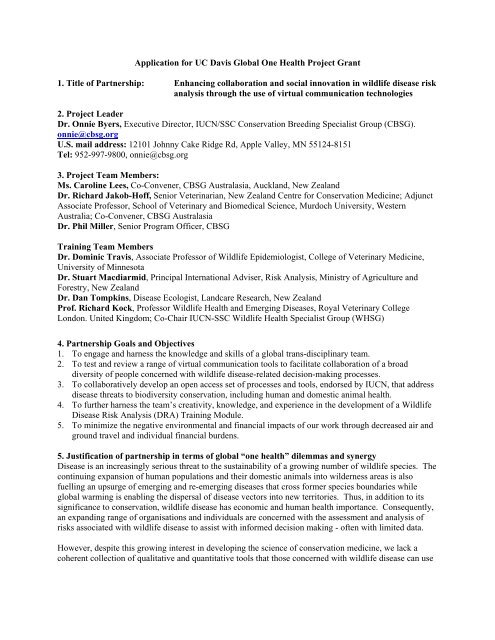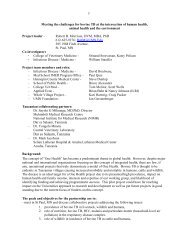Application for UC Davis Global One Health Project Grant 1. Title of ...
Application for UC Davis Global One Health Project Grant 1. Title of ...
Application for UC Davis Global One Health Project Grant 1. Title of ...
Create successful ePaper yourself
Turn your PDF publications into a flip-book with our unique Google optimized e-Paper software.
<strong>Application</strong> <strong>for</strong> <strong>UC</strong> <strong>Davis</strong> <strong>Global</strong> <strong>One</strong> <strong>Health</strong> <strong>Project</strong> <strong>Grant</strong><br />
<strong>1.</strong> <strong>Title</strong> <strong>of</strong> Partnership: Enhancing collaboration and social innovation in wildlife disease risk<br />
analysis through the use <strong>of</strong> virtual communication technologies<br />
2. <strong>Project</strong> Leader<br />
Dr. Onnie Byers, Executive Director, I<strong>UC</strong>N/SSC Conservation Breeding Specialist Group (CBSG).<br />
onnie@cbsg.org<br />
U.S. mail address: 12101 Johnny Cake Ridge Rd, Apple Valley, MN 55124-8151<br />
Tel: 952-997-9800, onnie@cbsg.org<br />
3. <strong>Project</strong> Team Members:<br />
Ms. Caroline Lees, Co-Convener, CBSG Australasia, Auckland, New Zealand<br />
Dr. Richard Jakob-H<strong>of</strong>f, Senior Veterinarian, New Zealand Centre <strong>for</strong> Conservation Medicine; Adjunct<br />
Associate Pr<strong>of</strong>essor, School <strong>of</strong> Veterinary and Biomedical Science, Murdoch University, Western<br />
Australia; Co-Convener, CBSG Australasia<br />
Dr. Phil Miller, Senior Program Officer, CBSG<br />
Training Team Members<br />
Dr. Dominic Travis, Associate Pr<strong>of</strong>essor <strong>of</strong> Wildlife Epidemiologist, College <strong>of</strong> Veterinary Medicine,<br />
University <strong>of</strong> Minnesota<br />
Dr. Stuart Macdiarmid, Principal International Adviser, Risk Analysis, Ministry <strong>of</strong> Agriculture and<br />
Forestry, New Zealand<br />
Dr. Dan Tompkins, Disease Ecologist, Landcare Research, New Zealand<br />
Pr<strong>of</strong>. Richard Kock, Pr<strong>of</strong>essor Wildlife <strong>Health</strong> and Emerging Diseases, Royal Veterinary College<br />
London. United Kingdom; Co-Chair I<strong>UC</strong>N-SSC Wildlife <strong>Health</strong> Specialist Group (WHSG)<br />
4. Partnership Goals and Objectives<br />
<strong>1.</strong> To engage and harness the knowledge and skills <strong>of</strong> a global trans-disciplinary team.<br />
2. To test and review a range <strong>of</strong> virtual communication tools to facilitate collaboration <strong>of</strong> a broad<br />
diversity <strong>of</strong> people concerned with wildlife disease-related decision-making processes.<br />
3. To collaboratively develop an open access set <strong>of</strong> processes and tools, endorsed by I<strong>UC</strong>N, that address<br />
disease threats to biodiversity conservation, including human and domestic animal health.<br />
4. To further harness the team’s creativity, knowledge, and experience in the development <strong>of</strong> a Wildlife<br />
Disease Risk Analysis (DRA) Training Module.<br />
5. To minimize the negative environmental and financial impacts <strong>of</strong> our work through decreased air and<br />
ground travel and individual financial burdens.<br />
5. Justification <strong>of</strong> partnership in terms <strong>of</strong> global “one health” dilemmas and synergy<br />
Disease is an increasingly serious threat to the sustainability <strong>of</strong> a growing number <strong>of</strong> wildlife species. The<br />
continuing expansion <strong>of</strong> human populations and their domestic animals into wilderness areas is also<br />
fuelling an upsurge <strong>of</strong> emerging and re-emerging diseases that cross <strong>for</strong>mer species boundaries while<br />
global warming is enabling the dispersal <strong>of</strong> disease vectors into new territories. Thus, in addition to its<br />
significance to conservation, wildlife disease has economic and human health importance. Consequently,<br />
an expanding range <strong>of</strong> organisations and individuals are concerned with the assessment and analysis <strong>of</strong><br />
risks associated with wildlife disease to assist with in<strong>for</strong>med decision making - <strong>of</strong>ten with limited data.<br />
However, despite this growing interest in developing the science <strong>of</strong> conservation medicine, we lack a<br />
coherent collection <strong>of</strong> qualitative and quantitative tools that those concerned with wildlife disease can use
to systematically assemble relevant data, objectively analyze disease risk, and confidently make in<strong>for</strong>med<br />
management recommendations.<br />
The ‘<strong>One</strong> <strong>Health</strong>’ paradigm and new disciplines like Conservation Medicine have emerged in an ef<strong>for</strong>t to<br />
address the complexity <strong>of</strong> disease within a broader ecological context than the currently dominant<br />
individual species focus. The trans-disciplinary and global collaborations required to enable this shift in<br />
direction will be greatly facilitated by the development and use <strong>of</strong> a range <strong>of</strong> virtual communications tools.<br />
6. Long-range Potential <strong>of</strong> Partnership and Potential Sources <strong>of</strong> Funding <strong>for</strong> Future Activities<br />
CBSG’s work in conservation is based on a central philosophy that people from many different<br />
backgrounds and perspectives are required to address the global biodiversity crisis. There<strong>for</strong>e, CBSG<br />
emphasizes the exchange <strong>of</strong> in<strong>for</strong>mation across diverse groups to reach agreement on the important<br />
challenges facing humans and wildlife. Currently, our Disease Risk Analysis initiative is doing this by<br />
bringing people together in interactive, participatory workshops that provide an objective environment,<br />
expert knowledge, and thoughtful group facilitation. Through developing a broad understanding <strong>of</strong><br />
challenges and alternative solutions, disease risk workshop participants can produce meaningful and<br />
practical tools that impact wildlife health and generate political and social support <strong>for</strong> conservation action<br />
– from local communities to national political authorities.<br />
CBSG has evolved greatly in its over 30 years <strong>of</strong> operation, and is now faced with the opportunity <strong>of</strong><br />
taking what could be a most dramatic and significant leap <strong>for</strong>ward. We have always been a participatory,<br />
collaborative organization with a philosophy <strong>of</strong> openness and inclusiveness. Today, technological tools<br />
are available that will allow us to engage this philosophy on a scale never be<strong>for</strong>e imagined. This project is<br />
designed to bring these concepts to the <strong>for</strong>efront <strong>of</strong> our thinking, to engage the leaders in the field <strong>of</strong><br />
wildlife health in meaningful discussion <strong>of</strong> the implications <strong>of</strong> these virtual tools on our work, and to<br />
develop a Wildlife DRA Training Module through the use <strong>of</strong> this technology. .<br />
7. Strategy to Achieve Objectives<br />
<strong>1.</strong> Engage and expand the global trans-disciplinary DRA team developed over the last year – see<br />
https://sites.google.com/site/cbsgdratoolkitreview/project-team.<br />
2. With the DRA team, review, test and evaluate the effectiveness <strong>of</strong> a range <strong>of</strong> freely and commercially<br />
available virtual communication and collaboration tools.<br />
3. Implement the strategy and timeline <strong>for</strong> completion <strong>of</strong> the DRA tools and processes as detailed in the<br />
Disease Risk Analysis Tool Development Workshop Report, April 2011 (attached as PDF).<br />
4. Hire expertise in the development <strong>of</strong> e-learning resources and adult learning principles to develop and<br />
pilot a Wildlife DRA Training Module.<br />
8. Indicators <strong>of</strong> Success<br />
<strong>1.</strong> Identification and introduction to the global wildlife health community, <strong>of</strong> a powerful, effective, and<br />
easy to use virtual collaboration toolkit.<br />
2. A published guide to the use <strong>of</strong> this toolkit - including principles <strong>of</strong> facilitating workshops within a<br />
virtual environment.<br />
3. The production and implementation <strong>of</strong> an electronic Wildlife Disease Risk Analysis Training Module.<br />
9. Evaluation Methodology<br />
We will apply a <strong>Project</strong> Logic framework that details, <strong>for</strong> each objective the rationale, detailed strategy,<br />
evaluation questions and sources <strong>of</strong> evaluation data. Metrics will include:<br />
Representation <strong>of</strong> the broad range <strong>of</strong> wildlife health stakeholder groups<br />
A virtual tool users satisfaction survey following the piloting <strong>of</strong> the DRA Training Module at a virtual<br />
training workshop<br />
Publication <strong>of</strong> the Virtual Collaboration Toolkit Guide
10. Budget<br />
Virtual Tools/DRA Program Officer (responsible <strong>for</strong> oversight <strong>of</strong> the project, and coordination and<br />
conduct <strong>of</strong> virtual tool identification, testing and training in the DRA context, and production <strong>of</strong> DRA<br />
training module); 18 hours/week <strong>for</strong> one year<br />
US18,000<br />
Purchase <strong>of</strong> preferred s<strong>of</strong>tware (est)<br />
Development <strong>of</strong> e-learning resources, adult learning principles and evaluation<br />
Total<br />
<strong>Project</strong>ed support from <strong>One</strong> <strong>Health</strong> Fund<br />
Funds provided from CBSG operating budget<br />
US$1,000<br />
US$4,000<br />
US$23,000<br />
US$10,000<br />
US$13,000<br />
1<strong>1.</strong> Biosketches<br />
Dr. Onnie Byers<br />
Onnie earned her Ph.D. in reproductive physiology from the University <strong>of</strong> Minnesota and<br />
completed a post doctoral fellowship at the Smithsonian Institution's National Zoo in Washington<br />
D.C. She joined the I<strong>UC</strong>N/SSC CBSG staff in 1991 as a Program Officer and is currently<br />
serving as the organization’s Executive Director. For over 30 years the CBSG has been the<br />
highly effective mechanism through which zoos and aquariums provide expertise and knowledge<br />
to the I<strong>UC</strong>N’s Species Survival Commission. In addition to oversight <strong>of</strong> the CBSG executive<br />
<strong>of</strong>fice, Onnie, along with her colleagues, is responsible <strong>for</strong> organization, design and facilitation <strong>of</strong><br />
species conservation planning workshops and strategic planning <strong>for</strong> conservation organizations.<br />
Onnie is dedicated to the transfer <strong>of</strong> CBSG’s tools and processes to conservationists around the<br />
world through the establishment and nurturing <strong>of</strong> regional and national CBSG Networks.<br />
Ms. Caroline Lees<br />
Caroline Lees is a conservation biologist with a particular interest in the application <strong>of</strong> small<br />
population biology to threatened species recovery. She is currently the Co-convenor <strong>of</strong> CBSG<br />
Australasia and a member <strong>of</strong> the I<strong>UC</strong>N/SSC Conservation Planning Sub-committee. In a<br />
previous role with the regional zoo association she developed principles and processes <strong>for</strong> widescale,<br />
science-based management <strong>of</strong> zoo populations towards conservation objectives and<br />
provided training, technical support and quality control <strong>for</strong> the region’s captive programme<br />
coordinators. Since joining CBSG two years ago she has worked as a population modeller and<br />
facilitator on a number <strong>of</strong> projects, including meta-population planning <strong>for</strong> Tasmanian devils and<br />
mala, and conservation planning <strong>for</strong> mountain bongos and scimitar-horned oryx. She is currently<br />
working on the development <strong>of</strong> virtual workshop environments <strong>for</strong> conservation planning and on<br />
the compilation and evaluation <strong>of</strong> conservation planning tools relevant to the I<strong>UC</strong>N’s new<br />
species conservation planning protocol.<br />
Dr Richard Jakob-H<strong>of</strong>f<br />
Richard Jakob-H<strong>of</strong>f is Senior Veterinarian - Conservation and Research at the New Zealand<br />
Centre <strong>for</strong> Conservation Medicine (NZCCM) at Auckland Zoo. He has also worked in zoos in
England, Jersey, and Australia and has been involved in many captive <strong>for</strong> release wildlife<br />
conservation programmes. He is co-author <strong>of</strong> the CBSG publication 'Animal Movements and<br />
Disease Risk' (2002); consultant to NZ Department <strong>of</strong> Conservation on wildlife health and<br />
disease risk issues - primary application <strong>of</strong> DRA tools has been in relation to wildlife<br />
translocations within New Zealand but increasingly addressing the growing need to apply these<br />
tools to disease risks to wildlife in situ.<br />
richard.jakob-h<strong>of</strong>f@aucklandcouncil.govt.nz<br />
Dr. Phil Miller<br />
Phil is a Senior Program Officer with the Conservation Breeding Specialist Group (CBSG), an<br />
international wildlife conservation organization that is part <strong>of</strong> the Species Survival Commission<br />
<strong>of</strong> the I<strong>UC</strong>N. Academically trained as a population geneticist and conservation biologist (PhD,<br />
Arizona State University), Phil integrates the use <strong>of</strong> computer simulation approaches <strong>for</strong><br />
population viability analysis with group facilitation tools to develop conservation strategies<br />
across a broad diversity <strong>of</strong> endangered wildlife species and against an equally diverse human<br />
cultural background. Through planning and conducting more than 75 risk assessment workshops<br />
in nearly 40 countries around the world, he has helped local people plan <strong>for</strong> endangered species<br />
conservation in the explicit context <strong>of</strong> human activities on the landscape. Phil has also been<br />
involved in CBSG’s Disease Risk Assessment project since the mid-1990’s, focusing primarily<br />
on the collaborative development <strong>of</strong> the disease dynamics simulation model called Outbreak, now<br />
used by CBSG and colleagues around the world to explore the impacts <strong>of</strong> disease on wildlife<br />
populations. His new area <strong>of</strong> research involves the integration <strong>of</strong> population viability analysis<br />
with tools from the field <strong>of</strong> decision analysis to help local wildlife management <strong>of</strong>ficials make<br />
more in<strong>for</strong>med decisions <strong>for</strong> species and habitat conservation.



